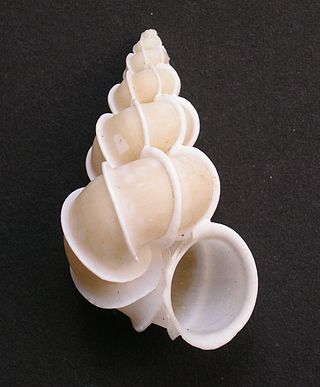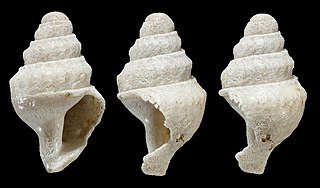
Sculpture is a feature of many of the shells of mollusks. It is three-dimensional ornamentation on the outer surface of the shell, as distinct from either the basic shape of the shell itself or the pattern of colouration, if any. Sculpture is a feature found in the shells of gastropods, bivalves, and scaphopods. The word "sculpture" is also applied to surface features of the aptychus of ammonites, and to the outer surface of some calcareous opercula of marine gastropods such as some species in the family Trochidae.
Anasirenites is a genus of extinct ammonoid cephalopods within the family Trachyceratidae which is part of the ceratitid superfamily Clydonitaceae; sometimes considered a subgenus of Sirenites. Anasirenites is characterized by a ventral furrow bordered on either side by a continuous keel. The shell, as for Sirenites, is compressed with whorls flattened-convex on the sides. Sigmoidal ribs on the flanks bifurcate near the ventro-lateral shoulder on tubercles and project sharply adorally. Whorl sides are tuberculate with tubercles arranged in spiral lines. The suture is ammonitic. Anasirenites, first described by Mojsisovics in 1893 is known from the Upper Triassic of the Alps, Sicily, and the Himalaya.

Aspidoceras is an extinct ammonoid cephalopod genus belonging to the family Aspidoceratidae.
Frechites is an early Triassic ammonite, a kind of cephalopod with an external shell, included in the ceratitid family Beyrichitidae.
Beyrichites is an extinct genus in the ammonoids cephalopod, order Ceratitida from the Lower and Middle Triassic of southern Europe, Asia, and western North America.
Beudanticeras is an extinct cephalopod genus from the Late Cretaceous period; Albian and Cenomanian, belonging to the ammonoid subclass and included in the family Desmoceratidae.
Zaraiskites is an extinct genus of ammonoid cephalopod that lived during the Tithonian.
Duashnoceras is an extinct ammonoid cephalopod genus included in the Stephanoceratidae that lived during the Bathonian stage of the Middle Jurassic.
Parastrenoceras is an extinct genus from the ammonoid cephalopod order Ammonitida, included in the family Spiroceratidae that lived during the Bajocian stage of the Middle Jurassic.

Leucosyrinx hemimeres is a species of sea snail, a marine gastropod mollusk in the family Pseudomelatomidae, the turrids and allies.
Gymnobela gypsata is a species of sea snail, a marine gastropod mollusk in the family Raphitomidae.

The Trachyceratidae is an extinct family of ceratitid ammonoid cephalopods.
Neoptychites is an extinct ammonoid cephalopod genus from the Turonian stage of the Upper Cretaceous, with a worldwide distribution.
Clionitidae is a family of generally evolute, Upper Triassic, ammonoids with a ventral furrow usually bordered by rows of tubercles and whorl sides ornamented by sigmoidal ribs which may bear spiral rows of tubercles. The suture is ceratitic.
Eoderoceras is an evolute, round whorled ammonite from the Lower Jurassic with an outer row of distinct spines, and in some, an inner row of tubercles, on either side; ribs only on the inner whorls.
Crucilobiceras is an ammonoid cephalopod genus from the Lower Jurassic belonging to the eoderoceratoidean family Eoderoceratidae. Cruciliboceras has an evolute shell, such that all whorls are well exposed, with persistent radial ribbing and with spines or tubercles on the outer, ventral, rim, and in some, tubercles in the inner, umbilical, rim. The genus Crucilobiceras is commonly found along the Jurassic Coast of England.

Turrilites is a genus of helically coiled ammonoid cephalopods from the lower part of the Upper Cretaceous ; generally included in the Ancyloceratina. Previously it was included in the ammonoid suborder, Lytoceratina.
Macrarene californica, common name the Californian liotia, is a species of sea snail, a marine gastropod mollusk in the family Liotiidae.
Dayiceras is a finely ribbed polymorphitid eoderoceratacean ammonoid cephalopod from the Jurassic, named by Spath in 1920. The shell is evolute, coiled such that all whorls are exposed. The whorl section is compressed such as to be higher than wide. A row of fine tubercles runs along the middle of the outer rim, the venter.

Theta spicea is a species of sea snail, a marine gastropod mollusk in the family Raphitomidae.





